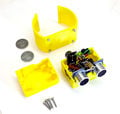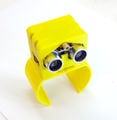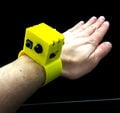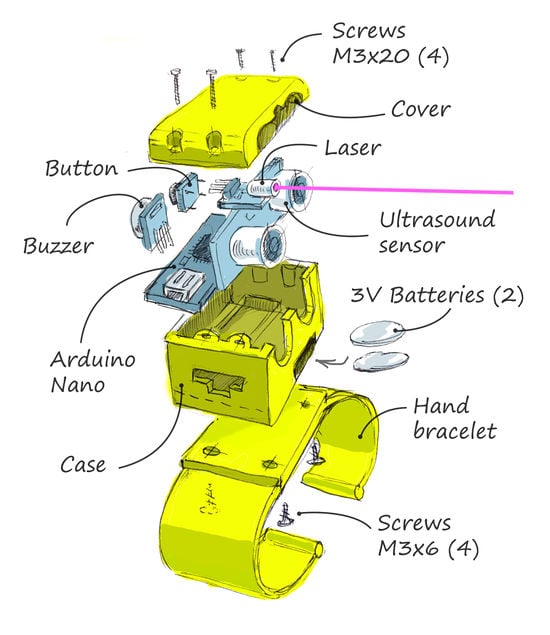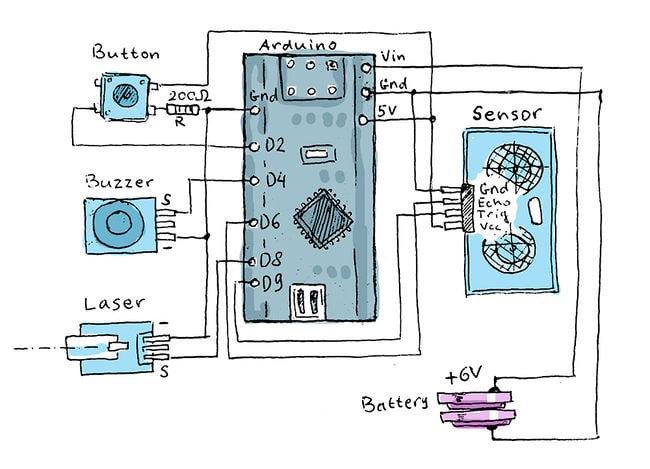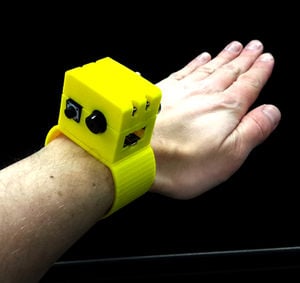
The given project is a part of Open Source Appropriate Technologies assignment, and it is designed to support visually-impaired people.
As per World Health Organization, there are about 300 million visually-impaired people in the world, 40 millions of them are totally blind. Scientists and engineers are working on systems which would be able to improve the quality of lives of people with the lost vision. A number of modern projects and achievements in this field has been listed in the Reference section.
The Blind Person's Assistant is based on ultrasound measurements. The sensor in bracelet measures distance in front of it in the range up to 12 feet (4 meters). In case of an obstacle in the range of 0.5 meters or closer, the buzzer creates a high sound and the low-power laser creates a light beam.
- Ultrasonic-based visually impaired person's assistant
-
Prototyping stage
-
Printed parts and soldered electronic components
-
Completed assembly
-
Testing procedures
Bill of Materials[edit | edit source]
The full list of materials used for the project is provided in the table below.
Total cost is $ 10.65.
- 3D source files could be downloaded from here: https://www.thingiverse.com/thing:3265022
- Code for arduino is available below. For arduino programming you may need the free open source Arduino IDE which could be downloaded from: https://www.arduino.cc/en/Main/Software
Code for Arduino Board
#define echo 8
#define trig 7
#define laser 4
long duration, distance;
const int buttonPin = 2; // the number of the pushbutton pin
int buttonState = 0; // variable for reading the pushbutton status
void setup() {
Serial.begin(9600);
pinMode(echo,INPUT);
pinMode(trig,OUTPUT);
pinMode(buzz,OUTPUT);
pinMode(laser,OUTPUT);
// initialize the LED pin as an output:
pinMode(ledPin, OUTPUT);
// initialize the pushbutton pin as an input:
pinMode(buttonPin, INPUT);
}
void loop() {
digitalWrite(trig,LOW);
delayMicroseconds(2);
digitalWrite(trig,HIGH);
delayMicroseconds(10);
digitalWrite(trig,LOW);
digitalWrite(laser,LOW);
// read the state of the pushbutton value:
buttonState = digitalRead(buttonPin);
// check if the pushbutton is pressed. If it is, the buttonState is HIGH:
if (buttonState == HIGH) {
// turn LED on:
digitalWrite(ledPin, HIGH);
digitalWrite(laser,HIGH);
} else {
// turn LED off:
digitalWrite(ledPin, LOW);
digitalWrite(laser,LOW);
}
duration=pulseIn(echo,HIGH);
distance=(duration/(2*29));
if(distance>=500 || distance<=0){
Serial.println("____");
} else {
Serial.print(distance);
Serial.println("cm.");
digitalWrite(buzz,LOW);
}
if(distance<=45 && distance>=1){
// distance in which the bracelet makes sound, you can edit according to your need
digitalWrite(buzz,HIGH);
digitalWrite(laser,HIGH);
Serial.println("Alarm!!!");
}
delay(400);
}
Tools needed[edit | edit source]
- MOST Delta RepRap or similar RepRap 3-D printer
- Plastic Filament
- Soldering Iron
- Solder
- Screwdriver
- Hexagon Key
- Breadboard
- Paper Knife
- Tweezers
- Wires Stripper
Skills and knowledge needed[edit | edit source]
All skills you need are at the basic level:
- 3D printing
- 3D Design
- Electronics
- Programming
Technical Specifications and Assembly Instructions[edit | edit source]
- First step is to 3D print all the necessary components (estimated printing time: 2.5 hours).
- Second step is to put all the electronic components together in the way they illustrated on Figure below (Assembling instruction on he left side).
- Third step - solder all the electronics according to the schematic provided on Figure below (Electrical schematic on the right side, estimated soldering time: 3 hours).
- Place soldered electronic components into the case as it shown on Figure below (left).
- Connect arduino board to a computer. Run the installed Arduino IDE with the code provided above.
- Upload the code to arduino and make sure it works properly.
- Now we can assemble the cover and screw it to the case.
- Finish assembling by attaching the bracelet to the case.
Common Problems and Solutions[edit | edit source]
- Solder all the wires with the components being in the place of the approximate final position. It may be complicated to bend soldered wires.
- Test your arduino wired and soldered with all the electronic components before assembling and screwing the cover or bracelet. It will be much easier to arrange all soldered wires or to debugging the arduino in case of any failure.
Cost savings[edit | edit source]
Currently there is no commercial options available on the market. The closest available alternatives are:
The prices for car ultrasonic radar systems varies from 17 to 25 dollars, so the cost savings could be from 62% to 235%.
Benefited Internet Communities[edit | edit source]
References[edit | edit source]
- ↑ Wafa Elmannai and Khaled Elleithy. Sensor-Based Assistive Devices for Visually-Impaired People: Current Status, Challenges, and Future Directions. US National Library of Medicine, National Institutes of Health, Sensors (Basel). 2017 March 2017. Available: http://web.archive.org/web/20170924044453/https://www.ncbi.nlm.nih.gov/pmc/articles/PMC5375851/
- ↑ Antonio Pereira, et al. Blind Guide: An Ultrasound Sensor-based Body Area Network for Guiding Blind People. Procedia Computer Science, v. 67, 2015, pp. 403-408. Available: https://www.sciencedirect.com/science/article/pii/S1877050915031312
- ↑ Rohit Agarwal, et al. Low cost ultrasonic smart glasses for blind. 2017 8th IEEE Annual Information Technology, Electronics and Mobile Communication Conference (IEMCON). Available: https://ieeexplore.ieee.org/document/8117194

